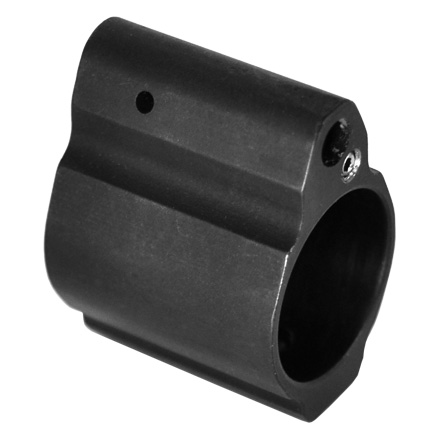Reducing the influence of excessive AR15 gas system pressure is most directly done reducing the pressure itself. Here’s how!
Glen Zediker
This is the second of two articles on ways to tame down an “over-functioning” AR15 gas system. Aside from running more reliably, reducing the evil influence of an overly-rapidly unlocking system improves cartridge case condition, which means longer case life. The first article talked about ways to increase the time the bolt stays locked, or delay its unlocking, however you want to see it.
Going more directly to the “source,” there are also ways to reduce the actual amount of gas that gets to the bolt carrier key and that’s up now for this one.

An adjustable gas manifold or “gas block” is an effective means to restrict the amount of gas that gets into the system. This device attaches at the port location, replacing the existing manifold (or front sight base if it’s a standard-configuration build) and will have some manner of valving function whereby propellant gases allowed to pass through the gas port in the barrel, through the manifold, and into and through the gas tube are restricted. Some incorporate a valve that regulates the passage dimension. Others provide a vent, more or less, to expel excess gas. I prefer the “valve-type” over the “bleed-off-style” devices.
Installation is straightforward, and these are available from a wide array of sources, so it shouldn’t be hard to find one that will fit even a custom-profile barrel. Standard for this area is 0.750-inches diameter. What matters is that the inside diameter of the manifold matches the outside diameter of the barrel at the connecting position.
There are different approaches to using this device but it’s really pretty simple. Figure out the minimum gas flow necessary to function the action and then open the flow-control screw adjustment a half turn more to give a little safety margin. Don’t get greedy. I shut one down all the way (minimum flow) and then open it up until the rifle functions.
The only foible on an adjustable manifold is that it has to fit in with the architecture of the setup you have. A retro-fit requires removing any muzzle device that might be installed and, of course, removing and later reinstalling the gas tube (make sure you check that it isn’t binding).
I have used other products that provide alternate means to do the same thing, like a gas tube with a valved adjustment mechanism. Sometimes something like that is best for anyone wanting to run a more standard gas manifold system. They work just fine, and dandy.

Other gas tube modifications that work have been those formed in a spiral that wraps around the barrel, and I’ve seen tubes with expansion chambers (area of larger volume) along the span of the tube. What’s happening with these isn’t reducing the amount of gas, it’s just giving it more distance or room to weaken its presence.
The best solution I’ve yet encountered is fairly new and is an adjustable bolt carrier key. This requires no modification or labor about the barrel, and also works with virtually any AR15. Remove the old carrier key and replace it with the adjustable key.

A good while back I talked about gas port pressure and propellant burning rates and cautioned against using a propellant on the slower-burning side of “suitable propellant chart” center. To reiterate, I don’t think any propellant slower than Hodgdon 4895 should be used, but I know full well I can safely extend that range one more step to say something like Varget or RE15 is the limit. Slower propellants create more gas port pressure because they peak farther down the barrel, nearer the gas port location. Related: I recommend to anyone who’s going to do a longer custom barrel to request that the builder relocate the gas port another inch forward. There’s more gas contained in a longer barrel for a longer time: more pressure hits the carrier key as a result.

No doubt, if you load up an AR15 with a heavy carrier and related parts then combine that with a gas restriction device, the range of propellants can move one or more steps slower-burning. In any of my full-blown across-the-course race guns, I can construct and successfully deploy loads that would wreck a rack-grade AR15. Don’t mess with that. Enjoy smoother and “softer” function and the assurance that you can run closer to a maximum load without fear of the odd and inevitable “pressure spike” causing problems. That’s why to do it.
The preceding was adapted from Glen’s newest book, Top-Grade Ammo, available here at Midsouth, click HERE to order. For more information on this book, and others, plus articles and information for download, visit ZedikerPublishing.com








